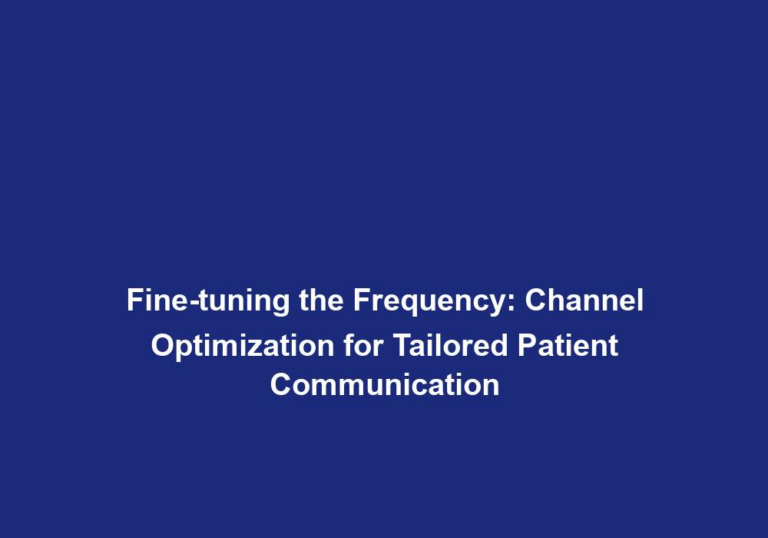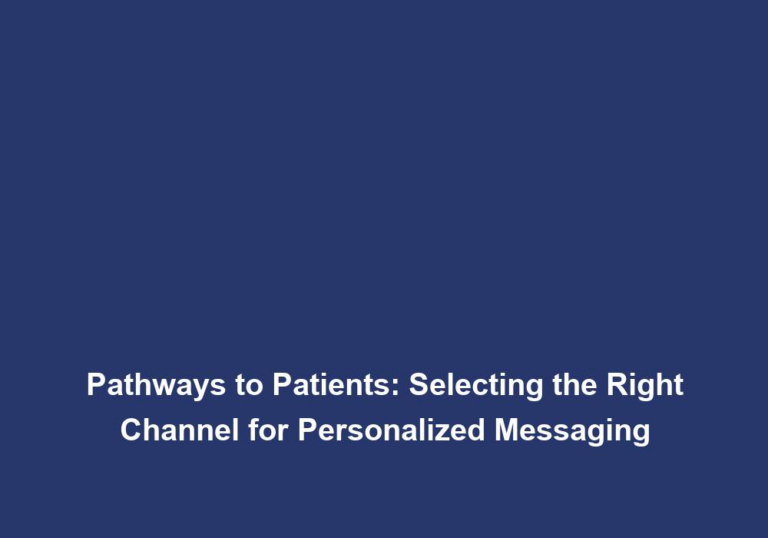Divide and Conquer: Harnessing Segmentation for Tailored Patient Communication
In the fast-paced world of healthcare, effective patient communication plays a crucial role in providing personalized care and improving health outcomes. One powerful technique that healthcare providers can utilize to enhance their communication strategies is segmentation. By dividing patients into distinct groups based on shared characteristics, segmentation allows healthcare professionals to tailor their communication efforts, delivering targeted and relevant information to each individual. In this article, we will explore the concept of segmentation and its significance in patient communication, along with practical tips for implementation.
Understanding Segmentation in Patient Communication
Segmentation involves dividing a target audience into smaller, homogeneous groups based on relevant factors such as demographics, health conditions, behaviors, and preferences. By recognizing that patients have unique needs and preferences, healthcare providers can create tailored communication strategies that resonate with specific segments.
Segmentation enables healthcare professionals to deliver information that is directly relevant to each patient’s circumstances, ensuring that they receive the right message at the right time. It allows for a more personalized approach, fostering a deeper connection between patients and healthcare providers, ultimately resulting in better engagement and adherence to treatment plans.
Segmentation is a valuable tool in patient communication as it allows healthcare providers to better understand their patients. By dividing the target audience into smaller groups, providers can gain insights into the specific characteristics, motivations, and preferences of each segment. This knowledge helps in developing communication materials that are highly relevant and resonate with the intended audience.
Segmentation also enables healthcare professionals to address specific concerns and preferences of different patient segments. For example, patients with chronic conditions may have different information needs compared to those seeking preventive care. By tailoring the communication to address these specific concerns, healthcare providers can effectively engage patients and improve health outcomes.
Furthermore, segmentation also plays a vital role in fostering a deeper connection between patients and healthcare providers. When patients receive communication that is tailored to their unique circumstances, they are more likely to feel understood and valued. This personalized approach helps build trust and strengthens the patient-provider relationship, leading to better engagement and adherence to treatment plans.
Benefits of Segmentation in Patient Communication
- Improved Patient Engagement: Segmentation helps healthcare providers understand their patients on a deeper level, enabling them to create communication materials that resonate with their intended audience. By addressing specific concerns and preferences, patients are more likely to engage with the provided information, leading to better health outcomes.
Segmentation allows healthcare providers to deliver information that is highly relevant and resonates with each patient segment. By understanding the unique needs and preferences of different segments, providers can create communication materials that effectively address their concerns. This personalized approach increases patient engagement as they feel that the information provided is specifically tailored to their needs.
- Enhanced Treatment Adherence: Tailored communication helps patients understand the importance of their treatment plans, leading to improved adherence. By recognizing the unique challenges and motivations of different patient segments, healthcare providers can provide information that directly addresses these factors, thereby increasing the likelihood of patients following through with their prescribed treatments.
Segmentation allows healthcare providers to customize communication materials to address the specific challenges and motivations of different patient segments. For example, patients in a certain age group may have different barriers to treatment adherence compared to others. By tailoring the communication to address these unique challenges, providers can improve treatment adherence and ultimately, patient outcomes.
- Efficient Resource Allocation: Segmentation allows healthcare providers to allocate their resources effectively by focusing on the segments that require the most attention. By identifying high-risk or high-value patient groups, providers can prioritize their communication efforts, ensuring that the right resources are allocated to those who need them the most.
Segmentation helps healthcare providers identify high-risk or high-value patient groups that require special attention. By focusing resources on these segments, providers can ensure that they receive the necessary support and information. This targeted approach optimizes resource allocation and improves the overall efficiency of patient communication strategies.
- Better Patient Satisfaction: When patients receive personalized communication that demonstrates an understanding of their needs, they are more likely to feel valued and satisfied with their healthcare experience. Improved patient satisfaction leads to stronger patient loyalty, positive word-of-mouth, and an overall improved reputation for the healthcare provider.
Segmentation allows healthcare providers to deliver personalized communication that addresses the unique needs and preferences of each patient segment. This personalized approach enhances patient satisfaction as they feel that their individual concerns are being acknowledged and addressed. Satisfied patients are more likely to remain loyal, recommend the healthcare provider to others, and contribute to a positive reputation.
Implementing Segmentation in Patient Communication
To effectively harness segmentation for tailored patient communication, healthcare providers should follow these practical steps:
1. Identify Key Segments
Begin by identifying the key segments that exist within your patient population. Consider factors such as demographics (age, gender, ethnicity), health conditions, lifestyle behaviors, and preferences. Conduct thorough research and analysis to understand the characteristics and needs of each segment.
Identifying key segments is the first step in implementing segmentation in patient communication. Healthcare providers need to analyze their patient population and identify groups that share common characteristics. This can include demographic factors such as age, gender, and ethnicity, as well as health conditions, lifestyle behaviors, and preferences. Thorough research and analysis are essential to gain a comprehensive understanding of each segment’s characteristics and needs.
2. Develop Patient Personas
Once the key segments are identified, create patient personas for each segment. These personas should encapsulate the typical characteristics, motivations, needs, and preferences of patients within each segment. The personas serve as a reference point for developing targeted communication materials.
Creating patient personas is a valuable tool for understanding and connecting with each segment. Patient personas are fictional representations of typical patients within each segment, capturing their characteristics, motivations, needs, and preferences. These personas serve as a reference point for developing targeted communication materials that effectively resonate with each segment.
3. Design Tailored Communication Materials
Develop communication materials specifically tailored to each segment. This includes creating patient education materials, brochures, online resources, and social media campaigns that address the unique needs and preferences of each segment. Use language and visuals that resonate with each group to enhance engagement and understanding.
Tailoring communication materials is essential to effectively reach and engage each segment. Healthcare providers should develop materials that address the unique needs and preferences of each segment. This can include patient education materials, brochures, online resources, and social media campaigns. Using language and visuals that resonate with each group enhances engagement and understanding, improving the overall effectiveness of the communication.
4. Utilize Digital Tools for Personalization
Leverage digital tools and technologies to personalize communication even further. Automated email campaigns, patient portals, and interactive websites can deliver targeted messages based on each patient’s segment. Implementing advanced analytics can also help track patient engagement and assess the effectiveness of communication strategies.
Digital tools play a significant role in personalizing patient communication. Healthcare providers can leverage automated email campaigns, patient portals, and interactive websites to deliver targeted messages based on each patient’s segment. These digital tools allow for precise targeting and customization, enhancing the effectiveness of patient communication strategies. Advanced analytics can also be implemented to track patient engagement and measure the success of communication efforts.
5. Continuously Evaluate and Refine
Regularly evaluate the impact of your segmented communication strategies and make necessary adjustments. Collect feedback from patients, measure engagement metrics, and track health outcomes to ensure the effectiveness of your efforts. Refine your communication materials and strategies based on the insights gained from continuous evaluation.
Evaluation and refinement are crucial aspects of implementing segmentation in patient communication. Healthcare providers should regularly assess the impact of their segmented communication strategies and make necessary adjustments based on feedback, engagement metrics, and health outcomes. Continuous evaluation allows providers to refine their communication materials and strategies, ensuring their ongoing effectiveness in addressing the unique needs of each segment.
Conclusion
Segmentation in patient communication is a powerful tool that enables healthcare providers to deliver tailored and relevant information to specific patient segments. By recognizing the unique needs, preferences, and circumstances of each segment, providers can enhance patient engagement, treatment adherence, resource allocation, and overall patient satisfaction. By following the practical steps outlined in this article, healthcare professionals can unlock the potential of segmentation and revolutionize their patient communication strategies for the better.






